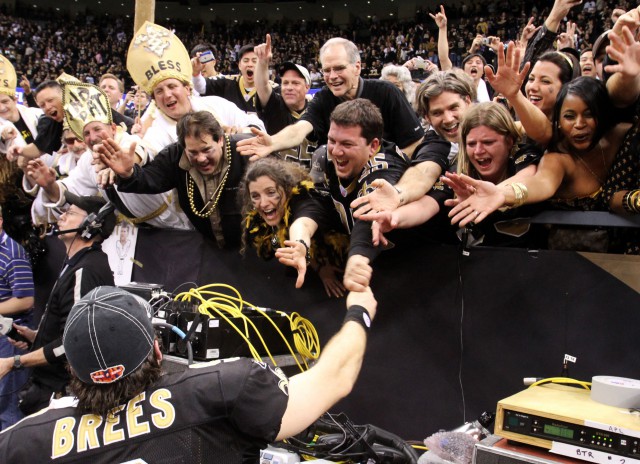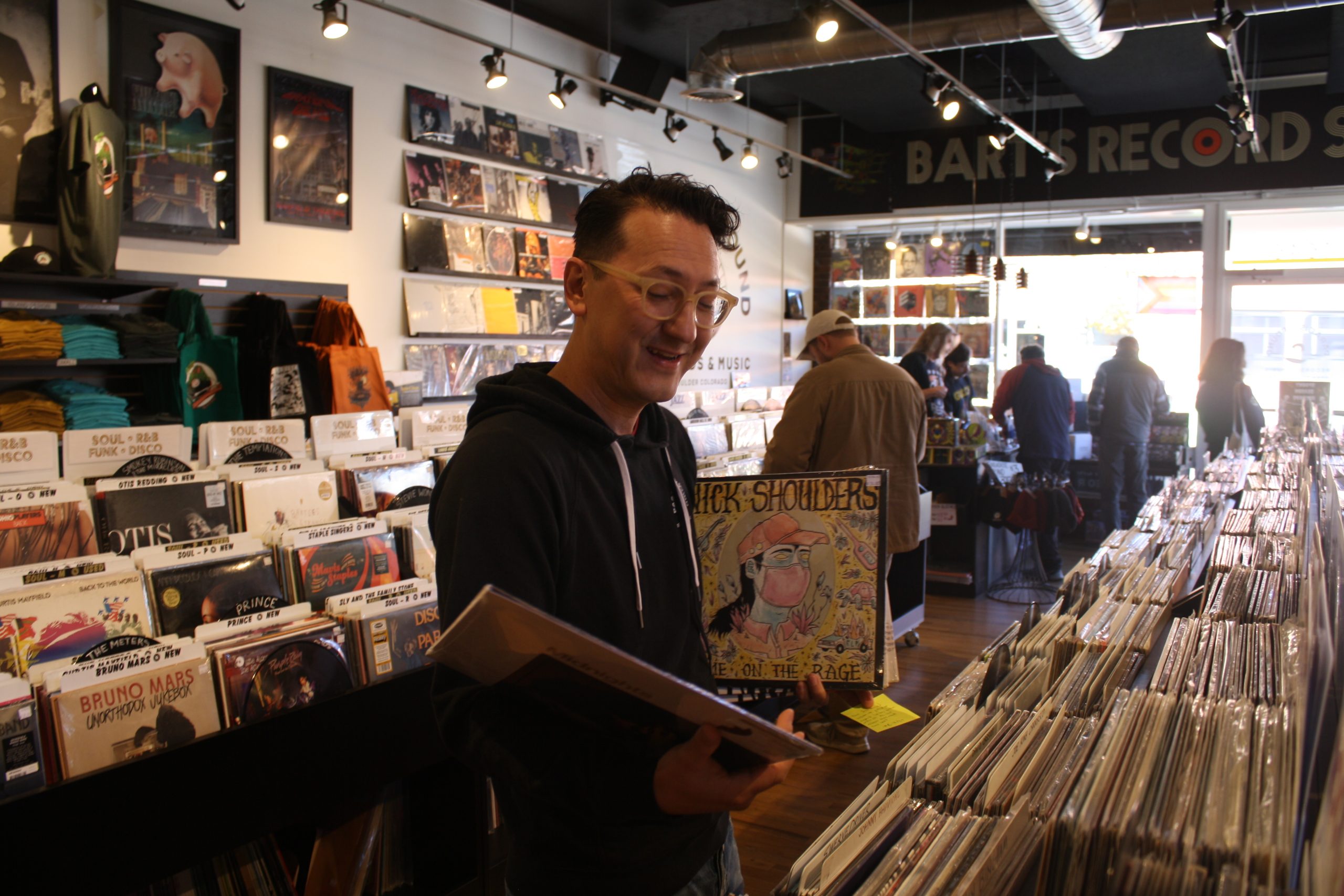
Editor’s note: Niwot resident Gary Gansar is a native of
New Orleans who moved to Boulder County 17 years ago.
Seemingly over-matched by a Minnesota Vikings team led by Hall
of Fame shoo-in Brett Favre, the New Orleans Saints finally advanced to the
Super Bowl for the first time in the franchise’s 42-year history with a 31-28
overtime win in the National Football Conference championship game. It was a
very special moment for a very special city.
Drew Brees, the saintly quarterback, raised the heavy George
Halas Trophy – signifying the NFC’s newly-crowned champion – high over his head
and he beamed broadly, then blew a kiss to the adoring throng of fans in the
Louisiana Superdome. It was easy to read the elation on his face. Streamers and
confetti fell from above, players embraced each other tightly, and the New
Orleans fans, with tears in their eyes, hugged, high-fived and screamed as they
had been screaming for a full four hours.
Hundreds of miles away and four-and-a-half hours earlier in
Indianapolis, Peyton Manning, another future Hall of Fame quarterback, accepted
the American Football Conference championship trophy with a simple nod of the
head and the nonchalance of one who has been here before and knows that the job
is not near finished.
The nation watched this tale of two cities with perhaps a
bit of amusement when considering those New Orleans denizens and their childish
delight. Several football commentators would, in fact, question the prematurely
overzealous reaction, one stating, “Uh, guys, this is not the Super Bowl.”
Those Saints faithful know that this was not the Super Bowl.
They know that they will be underdogs in the upcoming fight with the Colts, who
are led by New Orleans native son Manning, who grew up rooting for the Saints
from his home uptown. They know their chances at the next level are anything
but good — sportscasters almost universally forecast a Colt victory in Miami.
Yet there is something very special about this Saints team, about these Saints
fans, and about the story that binds them uniquely as no other sports team has
ever been fused to its city. As New Orleans expatriates by choice for 17 years
now, my wife and I have had the fascinating experience of watching a unique
culture from inside and out, and being present when it boiled over as it had
never done before in the wake of a conference championship (or even a Super
Bowl, for that matter), and we knew why.
A love story like no other
It is an unusual story that is worth telling to football
fans and non-fans alike. It is a love story like no other you have heard, and
it speaks of redemption – from a higher power, a power poorly defined, yet
palpable. It is a story of the downtrodden brought to the top against all odds,
and it is one of life’s precious moments that was shared by several hundred
thousand souls previously bound by misery.
The story begins in 1967, in Tulane Stadium, on the campus
of Tulane University. One of the largest stadiums in the country, it was filled
to the brim with New Orleans residents about to witness the inaugural official
game for their new professional team, the Saints.
I was a 12-year-old sitting in the north end zone when the
Los Angeles Rams kicked off to the south end zone, and John Gilliam returned
the opening kickoff that that inaugural game 94 yards for a touchdown. My
buddies and I whooped and high-fived, knocking my glasses from my face in the
process. This is easy, I thought.This is so cool. The Saints are going to be great.
Anyone who has followed professional football for the last
42 years knows that it has been anything but easy for the Saints. In fact, it
has been for the most part, a debacle.
Without going into 42 years of suffering, without talking about the brown
paper bags engulfing our heads, and without explaining how great players could
join a team year after year and not be great anymore – let’s suffice it to say
that the team sucked almost all the time.
As the millennium rushed past, support for the hapless
“’aints” began to wane, and Tom Benson, the owner, pondered moving the team to
San Antonio. Plenty of hearts were broken, and when he made the usual owner
demand that the state build his team a new stadium, the non-football fans bid
him farewell. The legislature balked, the governor intervened, and the move was
held in abeyance.
Saints and the Superdown
The Louisiana Superdome was a source of pride to a state
near the top of almost every bad list and the bottom of every good list. When
it was built, the political chicanery and subsequent brain damage made its very
existence a miracle. It was to be large enough to contain the Astrodome in
Houston, previously proclaimed “The Eighth Wonder of the World” by so many of
those Texans. It would look futuristic, sleek, and it would shield players and
fans from the intolerable and unpredictable weather.
The Superdome would soon be home to six Super Bowls, world
title fights, an NCAA basketball Final Four, as well as many international
events. The Superdome showcased the best of Louisiana and the future of New
Orleans to the world.
Now, after 25 years, the luster was off and the need for
expensive luxury boxes to support the escalating costs of professional football
was making it outmoded. Benson needed something better.
The question begged for a philosophical answer: “Should a
state that so poorly funded education, that was overwhelmed with poverty, and
that had so many more tangible needs, spend its meager funds and its future on
building a new stadium for a rich guy just so he could get richer?”
Then real tragedy hit in the form of the largest natural
disaster to stain the country, a hurricane named Katrina. I will not belabor
the point except to say the entire city and its suburbs were devastated. The
land was laid to waste, the population emptied New Orleans, and the government
was in disarray. The future looked so bleak that one consideration was to move
New Orleans and its port up the Mississippi River and start over.
The Superdome itself was horribly damaged. It had been the
refuge of last resort to the multitude of newly homeless victims, and it was
not prepared for that duty. People reverted to basic instincts where law did
not exist. Horrible conditions fomented crime and desperation. People died in
there, and bodies were placed in the refrigeration bins and stairwells. The
roof was partly torn away and the rains poured in. The once jewel of the city
was a ruin, a symbol now of the grime caked to the city’s underbelly.
Saints to San Antonio
New Orleans is not a city of people passing through. For the
most part, even the most miserable of its citizens will not leave. They grow
up, marry, have kids, and die there, knowing that the next generation will do
the same.
Those that could remain would certainly do so, and they had
to be supported. There must be priorities. There were innumerable problems, and
as a whole they threatened the future existence of a truly remarkable American
city.
The fact that the damage to the city had sent the Saints to
practice in San Antonio and scheduled to play some of their games there gave a
new urgency to the dilemma. Everyone realized that if this goes on for long, it
would be too easy to relocate the football team to the center of Texas, and it
would be a long time before the NFL looked upon New Orleans again.
What should be saved first, the infrastructure of the city,
the schools, the neighborhoods, or … the Saints?
Great thinkers and planners on both sides of the line had
reasonable arguments, but in the end it was decided that refurbishing the
Superdome would have the most immediate effect on the city’s future. It would
show the world that New Orleans was not going away, that it would not be moved.
It would give the people who lived there tangible evidence that things would
get better and that it was worth staying in the city and suffering now for a
brighter future. And it would put pressure on the Saints owner and the NFL to
maintain a holding pattern above New Orleans. How could they be taken from us
if we made them a top priority?
Would the public relations disaster that resulted from the
NFL delivering a body blow to a struggling underdog fighting against the
overwhelming reality of the profit motive in professional sports be worth the
resulting tarnish it would have to clean?
New Orleans rolled the dice, and once that decision was
made, the work on the Superdome and the Saint’s practice facility began with an
efficiency and alacrity that no other project in the state had ever experience
before or since. The Saints would stay put. The NFL and Tom Benson begrudgingly
accepted the crown of the beneficent.
{::PAGEBREAK::}
Intelligent design
A chain of events occurred that must be evidence of some
form of “intelligent design.”
First Payton, then assistant head coach of the Dallas
Cowboys, was offered his first head coaching job in the NFL with the Saints. He
took over a team that had won only three games the year before, second-worst in
the NFL, but pretty much the usual for the Saints. A few months later, he was
courting Brees, a free agent and former Pro Bowl quarterback with the San Diego
Chargers, who suddenly found his job in jeopardy with the rising, and youthful,
Philip Rivers nipping at his heels.
Payton got Brees and his wife to come to New Orleans to
check it out. The city was still in shambles, but Payton drove the couple
around, personally showing them neighborhoods that they could call their own if
they accepted his invitation to join the Saints. Unfortunately, as Payton would
later relate, he was new to the area himself and was not that familiar with
these neighborhoods. He took a wrong turn and was lost – for an hour. They
drove past miles of destruction. The major part of the tour that the Brees
family “enjoyed” were boats on top of houses, foundations where houses once
existed, and piles of rubble that used to be stores. Drew’s wife, Brittany,
yawned nervously.
Payton figured it was over, but Drew saw it another way. To
him, it was a sign. The wrong turn had a purpose, and Brees felt that he could
make a difference here. He could help rebuild these lives and this place.
This was far from the easy life in San Diego, but it was a
life with purpose — a personal purpose that a six-year, $60 million contract
would help him fulfill. He signed in March of 2006.
The following month, the Saints took Reggie Bush with their
first pick in the 2006 NFL Draft, the second-overall selection, after the
Houston Texans surprised the football world by passing him up. He said he
“could not wait” to get to New Orleans. This is something that the people of
the Crescent City had not heard in several years.
Return to the Dome
On Sept. 25, 2006, the Saints returned to the newly refurbished
Superdome to play their first home game there since the destruction of
Hurricane Katrina.
The city practically beamed with pride. The hurricane had
not defeated them. The dome was filled. The Saints were back. Their city was
saving itself and the fans were changing its destiny. That day, the Saints
defeated the Atlanta Falcons 23-3. By the end of the 2006 season, Payton was
named the NFL Coach of the Year.
The Saints players were loved by their town. Since the
hurricane, it was not that big anymore, and they were visible everywhere. These
guys had sacrificed quite a bit themselves in order to be here. There were
innumerable inconveniences and indignities, but not one had complained. They
could see what their fans were going through, and the players’ willingness to
be there was reassuring.
In addition, there were many charitable foundations set up
by individual players and their wives. The contributions became real when an
ancient, rundown, inner-city high school had its dirty grass field converted to
a brand new state-of-the-art stadium and track by Brees.
Thad Gormley Stadium, a WPA project from 1937, built in the
style of the Coliseum, had been used by New Orleans high schools and had been
the site of the only Beatles visit to New Orleans. Katrina left it looking like
a bowl of mud. Reggie Bush was a major force in bringing it back to life. A
plaque there thanks him for his efforts.
All of the players seemed to be involved in resuscitating
that city, and the people responded in kind. Black-and-gold banners began
appearing everywhere imploring — “Bless You Boys.”
Twelfth Man
Now it was Jan. 24, 2010. The uphill climb was almost to the
top. The end was in sight.
The Saints had the home field advantage for the NFC
championship game. That meant everything to the fans. Mostly, it meant that
they could take part in this Cinderella story. They could be the 12th Man. They
could push the adrenaline on the field to its maximum with their voices.
The day before the game, an article appeared on the top of
the front page of the Times Picayune,
explaining how to scream effectively, when to scream, and the importance of
screaming. The decibel level in the stadium would top 102, louder than a
jackhammer. Standing throughout the entire game like everyone else, and
screaming appropriately as directed, I found myself quietly pondering a Saints’
defensive change to myself. Suddenly, I felt a smack to the back of my head,
popping my fleur de lis-emblazoned Saints cap to the ground. I turned to find
an intense young lady, perhaps 25 years old, sticking her index finger in my
face like a schoolmarm. “Scream!” she demanded. “Every voice counts!” The
rallying cry for a city rising from the dead.
Our team may not go any farther than this championship this year. We may not win the Super Bowl in Miami, but forever those living in the City that Care Forgot during the last half a century will believe we are together and we are winners.



